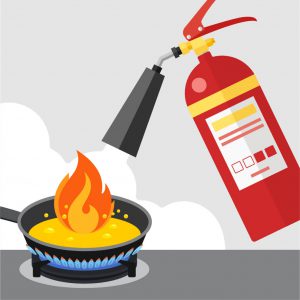How to Detect and Extinguish a Class F Fire (Cooking Oils & Fats)

What is a Class F fire?
Class F fires are fires which involve cooking oil or fat. Though technically a sub-class of fires caused by flammable liquids or gases, they differ from conventional fires due to the extremely high temperatures involved.
Whereas flammable liquids, such as petrol, usually have low flash and auto ignition temperatures, cooking oil or fats require temperatures in excess of 340°C to ignite. As such, the special characteristics of cooking oil and fat fires – specifically their higher flash point – have been recognised as important enough to categorise them separately.
Due to their nature, Class F fires occur in kitchens and food preparation facilities. Most of these fires are as a result of negligence in the kitchen – such as leaving pans unattended, not cleaning oil and fat from surfaces and not regularly changing the oil in deep fat fryers.
How do you extinguish a Class F fire?
In order to put out a fire, one element of it must be eradicated – the fuel, oxygen or heat. However, in order to do this successfully, the burning liquid’s temperature must be reduced to below its flash point which, when dealing with fat fires, is incredibly difficult to achieve due to their extreme temperatures.
As such, most ordinary fire extinguishers are unsuitable for Class F fires and, in some cases, can actually be very dangerous. For example, water fire extinguishers could create an explosion and cause the burning oil to disperse and the fire spread. Additionally, CO2 fire extinguishers and powder fire extinguishers could do more damage than good – to the fire, your property and the operative using the extinguisher itself.
Class F fire extinguishers should only be extinguished using a wet chemical fire extinguisher. These extinguishers have been specifically developed to tackle fires involving cooking oils and fats and contain potassium salts which both cool the flames and smother the fire’s oxygen content.
How do you avoid Class F fires?
If you own or manage a kitchen or food preparation facility – whether it’s a restaurant or hotel or part of a school, hospital or university – you have a legal obligation to protect your property and everyone within it from the threat of Class F fires. You must do everything possible to remove and reduce the risks associated with cooking oils and fats and unsafe kitchen procedures.
This involves regularly carrying out comprehensive fire risk assessments, assessing the dangers within your kitchen and managing them effectively, and implementing fire safety procedures accordingly – including installing wet chemical fire extinguishers (as part of a complete fire extinguisher system), fitting fire alarm systems and planning thorough evacuation plans in the event of a fire.
However, there are also a number of things you should do in an attempt to avoid Class F fires altogether. This includes training all your kitchen staff on safe work practices – such as regularly cleaning surfaces and changing the oil in pans and fryers and never leaving pots and pans unattended.
Unfortunately, it is almost impossible to avoid Class F fires completely – as there is no way of separating ignition sources with fuel sources. However, safe kitchen processes, regular staff training, the installation of a range of fire safety equipment and appropriate fire safety signage will make your environment – and the guests and employees within it – much safer.
Request a Callback
Just fill in your details below and we'll get back to you as soon as we can!

About Scutum London
Scutum London is a leading expert in fire safety and security solutions for businesses and organisations located across South East England, including London and Surrey.
From fire alarms, fire extinguishers and fire risk assessments to access control, CCTV and intruder alarm systems – and a lot more besides – we offer a comprehensive range of products and services designed to keep you, your business and your staff and visitors safe.
With decades of industry experience to call on, we’re proud to hold accreditations from leading trade associations and bodies such as British Approvals for Fire Equipment (BAFE), the British Fire Consortium, the Fire Industry Association (FIA) and Security Systems and Alarms Inspection Board (SSAIB).
If you’d like to find out more about Scutum London, get in touch with our friendly team or explore our products and services on our site.

